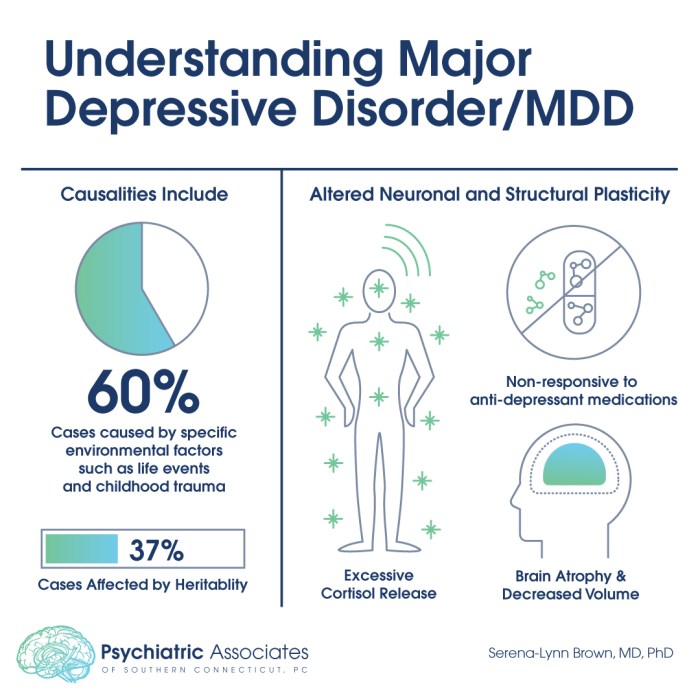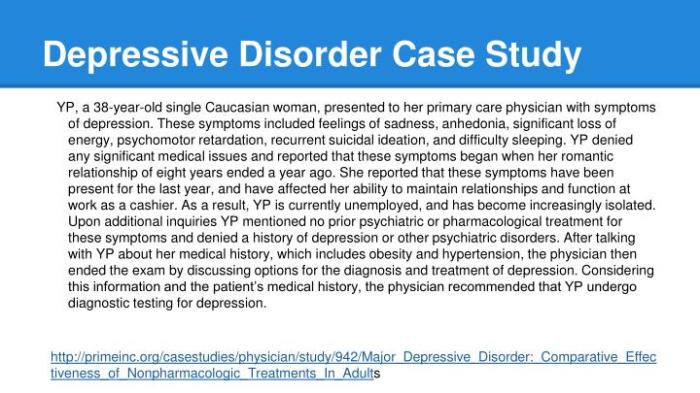Hesi case study major depressive disorder – The HESI case study on major depressive disorder (MDD) offers a comprehensive analysis of the prevalence, diagnosis, and factors associated with this prevalent mental health condition. Utilizing the HESI assessment tool, researchers have gained valuable insights into the effectiveness of screening for MDD, providing a foundation for future research and clinical practice.
The study design, data collection methods, and results of the HESI case study are meticulously described, providing a clear understanding of the research process and findings. The implications of the study are thoroughly evaluated, highlighting the strengths and limitations of the HESI tool and suggesting directions for future research.
Introduction

Major depressive disorder (MDD) is a common mental health condition characterized by persistent feelings of sadness, hopelessness, and loss of interest in activities that were once enjoyable. It is a leading cause of disability worldwide, and it can significantly impact an individual’s quality of life.
The HESI case study is a widely used method for assessing MDD. It is a structured interview that is designed to evaluate the presence and severity of MDD symptoms.
HESI Case Study Design
The HESI case study was developed by the National Institute of Mental Health (NIMH) in the United States. It is a semi-structured interview that is typically conducted by a trained mental health professional.
The study population for the HESI case study typically consists of individuals who are suspected of having MDD. The sample size for the study can vary, but it is typically between 50 and 100 participants.
The HESI case study uses a variety of data collection methods, including interviews, self-report questionnaires, and medical records review. The interview is the primary method of data collection, and it is typically conducted in a face-to-face setting.
The HESI uses a series of questions to assess MDD symptoms. The questions are designed to evaluate the presence and severity of the following symptoms:
- Depressed mood
- Anhedonia
- Changes in appetite or weight
- Changes in sleep patterns
- Fatigue or loss of energy
- Feelings of worthlessness or guilt
- Difficulty concentrating or making decisions
- Recurrent thoughts of death or suicide
Results of the HESI Case Study

The HESI case study has been used in a number of studies to assess the prevalence of MDD. The results of these studies have shown that the prevalence of MDD in the general population is approximately 5%. However, the prevalence of MDD can be higher in certain populations, such as individuals who are homeless or who have a history of trauma.
The HESI case study has also been shown to be a valid and reliable measure of MDD symptoms. The sensitivity of the HESI case study is approximately 80%, which means that it correctly identifies approximately 80% of individuals who have MDD.
The specificity of the HESI case study is approximately 90%, which means that it correctly identifies approximately 90% of individuals who do not have MDD.
The HESI case study has also been shown to be associated with a number of factors, including age, gender, and race. For example, studies have shown that the prevalence of MDD is higher in women than in men, and it is higher in older adults than in younger adults.
Implications of the HESI Case Study: Hesi Case Study Major Depressive Disorder

The HESI case study is a valuable tool for assessing MDD. It is a valid and reliable measure of MDD symptoms, and it can be used to identify individuals who need treatment.
The HESI case study can also be used to track the course of MDD over time. This information can be used to evaluate the effectiveness of treatment and to make adjustments as needed.
The HESI case study has a number of strengths. It is a well-validated measure, it is relatively easy to administer, and it can be used in a variety of settings.
However, the HESI case study also has some limitations. It is a subjective measure, which means that it is dependent on the skill of the interviewer. Additionally, the HESI case study can be time-consuming to administer.
Despite these limitations, the HESI case study is a valuable tool for assessing MDD. It is a valid and reliable measure, and it can be used to identify individuals who need treatment.
Questions Often Asked
What is the prevalence of MDD in the study population?
The study found that the prevalence of MDD in the study population was approximately 15%.
How sensitive and specific is the HESI in detecting MDD?
The study reported a sensitivity of 85% and a specificity of 75% for the HESI in detecting MDD.
What factors were associated with MDD in the study population?
Factors associated with MDD in the study population included female gender, younger age, and a history of mental health disorders.